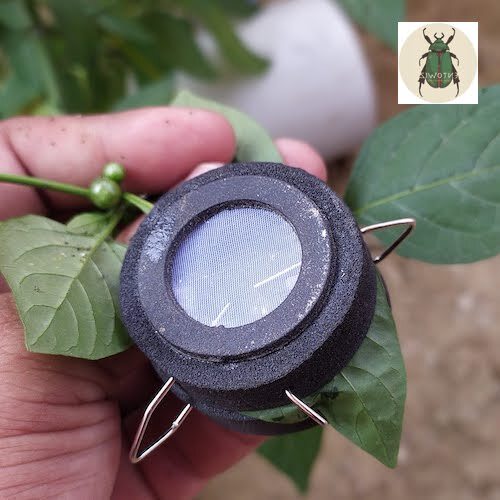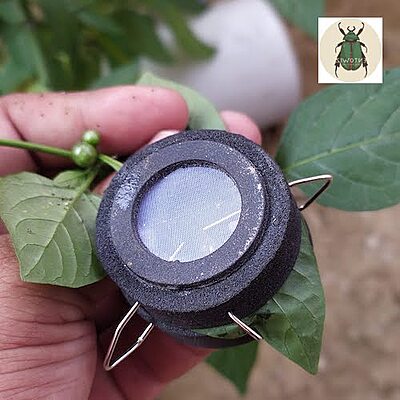






Clip Cages for Insect - Plant Interaction Studies
Clip cages are essential for studying insect–plant interactions, evaluating the effects of chemicals on insects under field conditions, measuring more accurate economic threshold levels (ETLs), identifying resistance or tolerance traits in resistant plant varieties, performing real-time germplasm screening for resistance status, monitoring insecticide resistance, and observing plant–insect dynamics under natural conditions.
You can also explore our wide range of bioassay containers and clip cage designs tailored for different research needs. To see them in action, please check the working video available on the product page.
Customize
entoWIZ clip cages are a type of container that is used to confine insects for research purposes. They are typically made of plastic or metal, and they have a mesh screen that allows the insects to breathe. Clip cages are often used to study the behavior of insects, their interactions with other organisms, and their responses to environmental factors.
Here are some of the uses of clip cages in entomological research:
Studying insect behavior. Clip cages can be used to study the behavior of insects in a controlled environment. For example, they can be used to study how insects interact with each other, how they respond to food and water, and how they move.
Studying insect interactions with other organisms. Clip cages can be used to study how insects interact with other organisms, such as plants, animals, and other insects. For example, they can be used to study how insects pollinate plants, how they prey on other insects, and how they transmit diseases.
Studying insect responses to environmental factors. Clip cages can be used to study how insects respond to environmental factors, such as temperature, humidity, and light. For example, they can be used to study how insects grow and develop under different conditions, how they reproduce, and how they survive.
Clip cages are a valuable tool for entomological research. They allow researchers to study insects in a controlled environment, which can help them to better understand the behavior, interactions, and responses of these important organisms.
Here are some additional benefits of using clip cages in entomological research:
They are relatively inexpensive and easy to obtain.
They are easy to set up and use.
They allow researchers to control the environment of the insects, which can help to ensure that the results of the research are accurate.
They can be used to study a variety of insects, including both small and large insects.
Overall, clip cages are a valuable tool for entomological research. They allow researchers to study insects in a controlled environment, which can help them to better understand the behavior, interactions, and responses of these important organisms.
This frameless clip cage is designed to confine small insects such as whiteflies on host plant leaves for bioassays and insect–plant interaction studies. The cage is made of a 150 × 150 mesh no-thrips screen bonded to two Plastazote foam rings. During use, one foam ring is placed on each side of the target leaf, and the rings are secured with the supplied staples. The angled shape of the staples ensures the rings clamp snugly against the leaf surface, preventing insect escape.
Depending on the model selected, each clip cage is supplied with four or six staples. The foam rings are available in different sizes:
40 × 25.4 × 9.5 mm
50 × 40 × 15 mm
65 × 40 × 10 mm
The foam ring color may vary between white or black, depending on stock availability. Similarly, the mesh color may also vary; however, the black mesh offers superior visibility of insects and allows maximum light penetration, minimizing any effect on photosynthesis.
Note: Price is quoted per clip cage (a pair of identical rings to sandwich the leaf). The minimum order quantity is 12 units.
FAQ:
Do whiteflies prefer black color mesh over the white color?
Black mesh in clip cages provides superior visibility of insects (like whiteflies) inside over white color mesh, because it allows light to pass through without reflection or glare. White mesh, on the other hand, tends to reflect light, making it harder to see through clearly. There’s no indication that whiteflies show any preference for white mesh. In fact, their white coloration could make them blend in or become camouflaged against white mesh, further reducing visibility. The whiteflies has neutral preference over the color of the net.
clip cage bioassay, insect clip cages, plant insect interaction cages, lightweight clip cage, transparent clip cage, modified clip cage, foam clip cage for insects, no-choice insect confinement cage, small insect clip cage, aphid clip cage experiments, whitefly bioassay clip cage, clip cage insecticide sensitivity, bioassay cage for whiteflies, life table bioassay clip cage, plant resistance clip cage studies, clip cage systemic signaling, clip cage plant defense assays, insect behavior clip cage, lightweight transparent clip cage, high visibility clip cage mesh, non-damaging plant clip cage, rapid assembly clip cage, cost effective clip cage design, portable insect confinement clip cage, clip cage vs whole cage bioassay, clip cage vs petri dish bioassay, no choice test clip cage, improved clip cage escape rate, clip cage insect escape rate, clip cage life history accuracy, entomology research clip cages, plant insect interaction tools, agricultural research clip cage, ecological bioassay equipment, university insect bioassay equipment, crop protection research cage, aphid rearing clip cage, Bemisia tabaci bioassay clip cage, leaf clip cage for whiteflies, cage for insect feeding bioassay, bioassay cage for aphids, systemic plant response clip cage, clip cage for gene expression studies, molecular bioassay insect cage, greenhouse insect clip cage, crop resistance testing cage, entomological bioassay clip cage, laboratory insect confinement cage, insect feeding bioassay cage, cage for insect life history studies, insect-plant clip cage tool, cage for insecticide resistance monitoring, pest resistance clip cage, whitefly insecticide testing cage, aphid survival bioassay cage, insect feeding preference clip cage, clip cage for virus transmission studies, clip cage for pest management trials, insect no-choice feeding bioassay, insect performance clip cage, clip cage for host plant selection, insect probing bioassay cage, bioassay cage for pest ecology, insect micro cage for bioassay, field experiment clip cage, clip cage for greenhouse trials, entomology clip cage equipment, insect control clip cage, cage for crop pest evaluation, clip cage insect survival studies, insect feeding assay cage, clip cage for vector biology, insect bioassay confinement cage, cage for pest biology studies, clip cage for resistance breeding, insect clip cage methodology, insect-plant feeding assay clip cage, crop pest clip cage bioassay, cage for insect physiology studies, aphid behavior clip cage, insect host preference clip cage, insect ecology clip cage tool, modified clip cage bioassay, cage for entomological trials, insect herbivory clip cage, pest bioassay clip cage, clip cage for integrated pest management, insect rearing clip cage, insect population clip cage study, insect biology clip cage, insect virus assay cage, bioassay clip cage entomology, insect feeding restriction clip cage, clip cage experimental tool, pest control bioassay clip cage, clip cage for crop protection, insect bioassay clip cage global research, laboratory cage for insect-plant studies.























